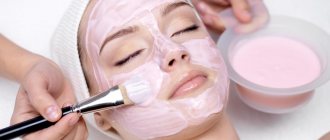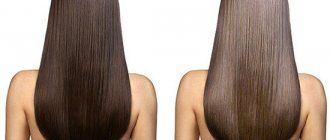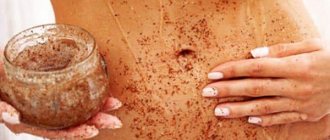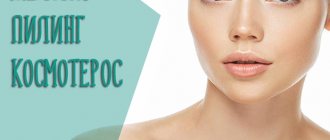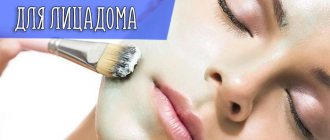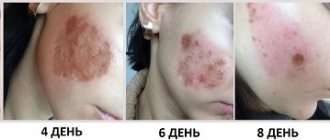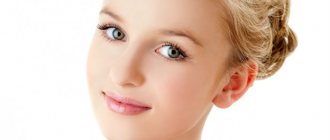Currently, in modern cosmetology there are a lot of procedures that help transform the skin on all parts of the body. One of the most famous and popular is superficial peeling. With its help, you can remove dead particles from the surface of the skin using special substances or devices. The procedure can be performed both at home and in a specialized cosmetology office. How peeling will be carried out depends on the characteristics of the skin. You can learn more about all the intricacies of peeling, its properties and cost by reading this article.
Superficial peeling
About peelings
Peeling has three types: superficial, medium and deep. It is easy to guess that their difference lies in the depth of action of the active components, which promote exfoliation of the stratum corneum and improve the formation of new cells. Peeling of the superficial type is the safest; it works gently on the skin, after which the skin quickly regenerates, which cannot be said about medium and deep peeling - in this case, rehabilitation will take much longer.
During the process of superficial exfoliation, the components act on the epidermis, due to which dead skin particles are separated. After the procedure, the speed of skin restoration increases, small wrinkles are eliminated, the skin on the face becomes fresh, smooth and healthy. Also, a peeling session helps fight rashes and other cosmetic problems. Superficial skin exfoliation can be performed in two ways.
- Impact at shallow depths. Peeling preparations only work on the surface layer of the skin.
- Impact at medium depth. Peeling works on several layers of the skin and also affects living cells.
Superficial peeling removes dead skin particles
Stages of the procedure
Stage one is preparatory. First, the cosmetologist cleanses the skin surface of cosmetic residues and dirt particles using a soft gel and foam. After this, the skin is degreased with a special lotion. Sometimes a gel with a small concentration of acids is applied before the main product to prepare the dermis for intense acid exposure.
Stage two is the main one. At this stage, the active composition is directly applied to the epidermis. The cosmetologist can apply it in two ways. The first is with light and quick movements, this is a more gentle method. The second is more aggressive, using a cotton pad and pressing on the skin surface. The retention time of the drug depends on the condition of the epidermis and the expected results.
Stage three – neutralizing . During this procedure, a special gel is applied to neutralize the effect of the acid. After this, all drugs are thoroughly removed with warm water.
Stage four – final . After the main procedure, a soothing and nourishing mask is applied to the face, followed by a light cream.
In the video you can see how superficial chemical peeling is carried out in a beauty salon:
Types of superficial skin exfoliation
There are four ways to perform superficial exfoliation of the skin - physical, biological, chemical and mechanical. Each method has its pros and cons. How accurately and deeply the peeling session will be carried out depends on exactly how it will be performed. Let's look at the types of peeling in more detail.
Mechanical . The simplest method of performing superficial exfoliation. Representatives of the fair sex have the opportunity to carry out the procedure themselves or visit a cosmetologist. Peeling is carried out using scrubs, which include salt, sugar and other components. Such scrubbing products contain solid abrasive particles - they delicately separate dead skin cells. In a salon setting, peeling can be carried out using hardware, but this procedure has not gained popularity due to painful sensations.
Note! Specialized creamy textures - gommages - are also quite often used for the purpose of superficial peeling; in addition, they are used to massage the facial area.
Scrubs can be used for superficial peeling
Physical . Such peeling can, as a rule, only be carried out in a salon, because it is carried out using hardware. Exfoliation of the skin involves equipment that produces ultraviolet light, ultrasound, liquid nitrogen, carbon dioxide, and steam. This type of peeling can be performed using a laser beam - this method helps the active components penetrate more accurately.
Note! Ultimately, it is possible to treat each individual skin layer at different depths.
Superficial peeling can also be carried out using devices
Biological . The session is carried out using enzymes. The substance contains a protein enzyme - it increases the speed of reactions occurring in the layers of the skin, as a result of which renewal processes are accelerated.
Chemical . Fruit acids take part in this type of peeling. If the procedure is carried out correctly, the skin tissue is not damaged. Acid components have an effect on skin tissue, activate exfoliation and further cellular regeneration. The most popular chemical peels are malic, lactic, glycolic and tartaric acids.
Note! For example, glycolic acid helps collagen production, has antiseptic and antioxidant properties - all this has a beneficial effect on aging skin.
Peeling is often done using fruit acids
Cosmetologists often perform the following superficial peels.
- With the participation of alpha hydroxy acids. This exfoliation is gentle, effective and safe. The most popular is a concentration of 30-70%, pH 0.1-3.0. During the session, erythema and peeling are sometimes noted. After 2-3 days, these symptoms will go away on their own.
- With the participation of glycolic acid. This type of exfoliation not only removes dead skin but also enhances collagen production and release. The session will help normalize the moisture level of the epidermis, even out the complexion, and eliminate the proliferation of bacteria. Representatives of any age category can resort to such peeling. After the session, small wrinkles are eliminated. Immediately after the procedure, redness of the skin is often noted, but there is no need to worry - it will go away on its own after 3-4 hours.
- With the participation of retinoic acid. This procedure does not injure the skin, and the result will be the same as after an intermediate facial peeling. This method is needed to combat involutional changes in the layers of the epidermis. The session eliminates rosacea well, but will not help remove wrinkles that appear due to active facial expressions.
Retinoic acid is also used
Superficial exfoliation of the skin should be carried out by a cosmetologist with extensive experience - only then the procedure will be as safe and non-traumatic as possible.
Note! Women during pregnancy and breastfeeding should consult a doctor before the procedure.
Operating principle
As the name suggests, this type of chemical peel only affects the surface of the epidermis, and this has its pros and cons. Although, in principle, by adjusting the concentration and residence time of acids, which are the basis of almost all peeling preparations, the doctor can also make a medium or deep peel. They are already classified as therapeutic and rejuvenating procedures, but after them there is a period of active rehabilitation with numerous restrictions.
Superficial peeling does not damage the skin. The concentration of acids is so weak that they only dissolve dead skin scales from the upper layer of the epidermis and practically do not irritate the skin. Accordingly, the patient does not experience pain during the procedure.
The correct choice of the drug allows you to obtain some additional effects, which are a pleasant bonus to the primary task of surface peeling - cleansing.
Exfoliating the skin with chemicals
This type of peeling is called “lunch peeling”. It is quite gentle on the skin compared to other chemical peels; it does not require long and complex preparation, and there are no traces left after it.
During the process of superficial peeling, old cellular units are separated. The thickness of their layer is approximately 0.06 mm, but this is already enough for the face to become noticeably fresher, the condition of the skin to improve, inflammation to decrease, shallow wrinkles to level out, pigmentation to become less pronounced, and pores to decrease in size. In order for the result to last longer and be more pronounced, it is necessary to perform a course peeling approach. It involves repeating sessions every few weeks (the required number of sessions is prescribed by the doctor).
Note! The duration of a peeling session is about 10-30 minutes; there is no pain during the process, but it may sting and burn the skin a little.
Despite the superficial effect, the result is clearly visible
Superficial exfoliation of the skin is often impossible without the use of products whose active components are fruit acids. They are also called AHA (alpha hydroxyl). AHA exfoliation includes, for example, almond peeling - the substance used in this peeling includes acid obtained from bitter almonds.
Superficial exfoliation can also be done with glycolic acid. Its huge advantage lies in the very small size of the molecular particles - they easily penetrate the protective layer of the skin without injuring it, and trigger the stimulation of active collagen production.
Superficial exfoliation works well on young skin (20-35 years old) even when there are no serious deficiencies, but only sebum secretion and oily sheen, local inflammation and slight pigmentation are of concern. Currently, the cosmetic market offers a wide variety of kits designed for superficial peeling at home, and you can choose an option in any price category.
Note! Manufacturers provide information that the use of such products provides 30% of the results that can be achieved in a beauty salon.
You can carry out the procedure at home, but the result will not be very pronounced.
The middle place is given to retinoic and salicylic skin exfoliation (BHA). They are classified as “superficial-medium” peels because they can work in deeper layers of the skin compared to fruit acid peels. However, this does not cause injury to the skin, so this peeling is appreciated by patients. The Jessner Peel is an exfoliating procedure performed using a mixture of retinoic, lactic and salicylic acids, and is quite often used in some beauty salons.
A superficial Jessner peel may be performed.
Types of peelings
In addition to mechanical (scrubbing and microdermabrasion) and ultrasonic, chemical surface peelings, there are three main groups: enzymatic, acidic and combined. Which one is best to do in a particular case is determined by the doctor, since each of them has its own characteristics.
Enzymatic
This type of peeling has the mildest effect and does not irritate the skin at all. There are no acids in it, and the loosening and dissolution (not even exfoliation!) of cells is provided by enzymes of plant or animal origin:
- Papain. Extract from papaya fruit and leaves. Has an anti-inflammatory effect and normalizes sebum secretion.
- Bromelain. Present in pineapples, wild lemon. Effectively eliminates pimples and acne, relieves inflammation, improves intracellular metabolism.
- Trypsin. Extracted from the pancreas of cows. Has anti-inflammatory and decongestant effects.
- Pepsin. Animal enzyme from the gastric lining of cows or pigs. Promotes the breakdown of proteins into peptides easily absorbed by cells.
- Lysozyme. A component present in chicken egg white that stimulates the immune system, with strong antibacterial and anti-inflammatory effects.
- Sorbaine. Herbal component from papaya or lemon fruits. It perfectly destructs dead cells and increases metabolic rate.
Superficial peeling with enzymes can be done at home. To do this, it is enough to buy a high-quality ready-made product (in a professional or even an ordinary cosmetic store) and, after carefully studying the instructions, use it yourself from one to three times a month.
In salons, professional products are used for this, but they are used only for hypersensitive and/or very young skin.
Enzyme peeling is also often combined with ultrasonic facial cleansing. This allows you to remove more dead cells, since the product partially dissolves them, and the scrubber blade effectively removes them.
Acidic
The most common type of chemical peels is acid peels. As the name implies, their main components (and sometimes the only ones) are various types of acids, the concentration of which does not exceed 25%. They have characteristic properties, and an experienced doctor, knowing this, can select a drug that, during cleaning, solves some skin problems:
| Name | Description |
| Almond | The most delicate type of peeling that can be used even in summer. Does not provoke irritation or allergies, does not dry out the skin. Cleanses pores well and removes signs of photoaging. |
| Glycolic | It has a small molecular size, thanks to which it penetrates deeper than others. Can be used for superficial-medium exposure. Suitable for any skin type, it perfectly improves skin turgor and improves complexion. |
| Fruit | Fruit acids are able to stimulate active cell regeneration, so they are often used as a means of combating the first wrinkles and preventing early aging. But the risk of allergies to them is quite high; this procedure is not suitable for sensitive skin. |
| Retinoic or yellow peeling | Used for older skin that has lost turgor - from 30-35 years. It is able to restore its elasticity, stimulates metabolic processes, and effectively eliminates shallow pigmentation, as well as traces and spots from acne. |
| Pyrovinogradny | An excellent soft hypoallergenic exfoliant. It has antibacterial, anti-inflammatory, sebostatic properties. Does not dry out the skin. |
And these are just the five main types of acids. In fact, their list is much longer. Acid cocktails may include: malic, citric, acetic, phytic, azelaic, etc. This is why it is so important, even if you decide to do the peeling at home yourself, to consult with a specialist on the choice of drug.
Combined
A striking example of a combined type is the Jessner peel. It has a three-component composition, which in the classic version combines:
- Acetylsalicylic acid. Provides gentle but effective exfoliation of dead cells, narrows enlarged pores, kills pathogenic microorganisms, and regulates the activity of the sebaceous glands. The product is widely used for problem skin and helps fight pimples and acne.
- Lactic acid. Promotes deep hydration and stimulates the synthesis of hyaluronic acid. Prevents severe drying and irritation of the skin during the procedure, allowing it to be performed even on sensitive skin.
- Resorcinol. A substance with strong antibacterial and anti-inflammatory properties. Helps fight certain types of dermatological problems.
The standard concentration of acids in the Jessner peeling preparation is 14%, but now there are other versions with an increased content of lactic acid. It is applied in layers, the number of which the doctor regulates independently, focusing on the patient’s age and skin condition.
There are also many varieties of combination peels. Some of them contain up to 7 types of acids and contain additional ingredients that improve the condition of the skin and stimulate its rejuvenation. But they are more often used as superficial-medium peeling, as they penetrate quite deeply into the epidermis.
Who is recommended for superficial peeling?
Any procedure performed by a cosmetologist has indications for its implementation. Peeling can be used for any skin type - dry, oily, combination - there are no restrictions.
If there is increased oiliness of the skin, sessions should be performed more often than in the case of a normal or combined type.
Note! The fair half of humanity can perform superficial peeling of the facial area once every 14 days, and of the body - once every 7 days.
If your skin is oily, it is recommended to exfoliate more often.
When is superficial peeling required:
- if the patient has increased oiliness of the skin, skin prone to inflammation;
- for medicinal purposes in the fight against acne;
- to reduce pore sizes;
- to eliminate age-related defects of the skin;
- to reduce age spots;
- with seborrhea;
- for the purpose of post-acne correction.
There are certain indications for such peeling
At the end of the session, you can immediately notice positive changes: the surface of the skin is smoothed, leveled, mild wrinkles are eliminated, color is improved, the face once again glows with health and beauty. Exfoliation is necessary to eliminate cosmetic imperfections of the skin, as well as to prevent enlarged pores and the occurrence of acne.
It should be noted that it is possible to obtain a long-term effect from superficial peeling only if it is repeated frequently. The duration and number of peeling sessions are determined by the cosmetologist, based on the condition of the patient’s skin and his age category.
During the period after the procedure, it is necessary to provide the skin with appropriate care and protect it from external unfavorable factors: UV radiation, cosmetics, mechanical trauma (epilation).
Note! If you follow this rule, the recovery period will proceed quickly and easily.
After the procedure, it is important to carefully care for your skin.
Post-peeling care
In the before and after photos you can see that superficial chemical peeling causes severe peeling on the skin. To eliminate them, you need to provide it with constant moisture. For this purpose, intensive creams and masks are selected. The use of scrubs is prohibited during the entire rehabilitation period. You also need to limit your time spent outside.
For the renewed layer of the epidermis, not only the sun's rays are harmful, but also wind, dust and other irritating factors. They can cause infection.
Photo - Pigment spots after peeling
Care Tips:
- Use moisturizer regularly;
- For the first 3 days, do not apply foundation or powder to your face;
- Cleanse the skin exclusively with mild lotions. The best choice is micellar water;
- When going outside, you need to provide a level of protection from UV rays (depending on the time of year).
Benefits of superficial peeling
Superficial peeling has a lot of useful properties, which is why the fair sex loves this procedure and constantly resorts to it.
Without pain . The active substances work on the surface of the skin, and this does not cause pain - only a minimal burning sensation is possible.
Short-term rehabilitation . The skin returns to its previous appearance in just a couple of days, redness and peeling go away quite quickly, which cannot be said about deep peelings.
Rehabilitation after this procedure does not last long
There is no seasonal restriction on the procedure . Superficial peeling can be performed all year round. During the period of active solar radiation, it is necessary to limit the effect of sunlight on the skin - the use of sunscreen will be required.
Harmlessness. The likelihood of severe injury to the skin in the form of burns during a peeling session is minimized.
Before going for a superficial skin exfoliation procedure, women need to remember that after the cosmetologist’s manipulations, redness, dryness and peeling of the skin may appear. This skin behavior is considered normal; unpleasant symptoms will go away after a couple of days.
Note! Mistakes made during the procedure and negligent attitude to contraindications are fraught with unpleasant consequences - the condition of the skin tissue may worsen and pigmentation may increase.
Side effects may occur for some time
Indications and contraindications
Indications for the superficial peeling procedure:
- the appearance of the first signs of aging;
- the appearance of facial and age wrinkles;
- the presence of pigmented areas on the skin;
- acne and post-acne;
- uneven complexion;
- inflammatory rash;
- the presence of scars and cicatrices;
- weak skin tightness.
Regular professional peelings help to quickly get rid of these shortcomings in 90% of cases. The chemical composition of the products has a cleansing, exfoliating, whitening and rejuvenating effect, so after just a few sessions the rash disappears, wrinkles are smoothed out, and the skin surface acquires a healthy tone and radiance.
Despite all the advantages, this cosmetic procedure also has contraindications:
- pregnancy and lactation;
- oncological diseases;
- diseases of the cardiovascular system;
- dermatological diseases in the acute stage (herpes, demodicosis);
- bacterial and viral infections;
- allergy to active ingredients or peeling components;
- the presence of neoplasms on the skin (warts or papillomas);
- fresh tan;
- the presence of wounds, scratches and other damage on the skin surface.
Contraindications
Anyone who wants to peel their skin should be aware of the contraindications to this procedure. If the patient does not take them into account, he will not receive the desired effect from the session; rather, on the contrary, the skin condition may worsen, the risk of burns, increased age spots, progression of acne, and others increases. Superficial peeling may be contraindicated in such cases.
- Acute viral diseases (herpes).
- Acne has worsened.
- There are purulent inflammations on the skin.
- There is an allergy to the skin.
- Combined use of aromatic retinoids.
- Recently, before the peeling procedure, other cosmetic procedures were performed that could damage the skin.
- Damage in the form of cuts and abrasions.
- There is a risk of intolerance to the active substances of peeling preparations.
The procedure has contraindications
Kinds
Based on the mechanism of action, superficial chemical peeling of the face is divided into several main types.
Mechanical
The main goal of this technique is to remove dead cells using solid particles. In this case, the procedure is carried out with a scrub or diamond chips. A special metal brush can also be used.
Microdermabrasion also involves vacuum cleansing with a special device. During this manipulation with negative pressure, dirt and sebaceous secretions are removed from the pores.
Hardware
This category includes ultrasonic and laser types of peeling. These include fractional photothermolysis and diamond type dermabrasion. To achieve the desired result, you must complete the full course. However, depending on the severity of the defect, sometimes one session is enough.
Chemical
Involves the use of fruit acids and alkalis.
Classified into several types.
Enzymatic
The main component of the products used is not acid, but plant and animal enzymes. They have a softening effect on the surface layers of the skin, helping to cleanse the skin of dead cells and protein compounds.
This peeling can be used even for sensitive skin types. In most cases, the drugs contain sorbaine, pepsin, pancratin, papain, and bromelain.
Combined
Application is based on enzymes and AHA acids.
Acid
The basis of the composition of exfoliating products is glycolic, fruit, salicylic and lactic acids. The procedure is prescribed to prevent premature aging, the appearance of facial wrinkles, and also if there is skin pigmentation.
The acid type of peeling has several types depending on the component used.
Almond
The procedure involves exposing the skin to phenoxyglycolic acid, which is extracted from bitter almond extract. Maximum effectiveness is observed when removing acne and symptoms of photoaging. The method is safe and does not pose a threat even in the presence of hyperpigmentation. In addition, it is hypoallergenic.
Lactic
Products containing this component are gentle and cannot provoke an allergic reaction. Thanks to this product, the skin takes on a healthy and fresh appearance, the tone is evened out, and elasticity appears.
Glycolic
The acid is produced from sugar cane. This peeling helps to increase the permeability of the basement membrane, which ensures deeper penetration of nutrients into the layers of the dermis. The effect is expressed in increasing the firmness and elasticity of the skin, leveling the relief.
Salicylic
This substance differs from others in its pronounced comedolytic property. Can be used for the appearance of various rashes and acne.
Retinoic
Prescribed to women over 35 years of age. Thanks to this technique, it is possible to cope with the first signs of aging, eliminate age spots, scars, scars and the consequences of acne.
Jessner Peel
In this case, the main components are lactic and salicylic acids. Resorcinol is added to the composition. High effectiveness is noted in the fight against problems such as seborrhea, freckles, acne, acne, hyperpigmentation, lentigo.
TCA peeling
It is a traumatic procedure. It has lifting, antioxidant, bactericidal, restoring and whitening properties.
Superficial peeling as a salon procedure
Skin exfoliation in a beauty salon will not be limited to one visit. After an in-person consultation and assessment of the condition of the skin, the doctor will determine the required number of peeling sessions. Typically this number of sessions varies from 6 to 10.
Note! Between sessions it is necessary to maintain an interval of 14 days.
What is the procedure for a session in a salon:
- the first step is to clean the skin, then steam it to expand the pores;
- application of the peeling preparation. The substance is applied using a cosmetic brush or a cotton swab. A tingling or burning sensation may appear, but there is no reason to worry, since this is the skin’s natural response to the irritant. When 5-10 minutes have passed, the cosmetologist will remove the drug from the face;
- The session ends with a light massage of the treated area and applying a nourishing cream to it.
The procedure is carried out in several stages
Mechanism of action
Superficial facial peeling refers to exposure of the skin to abrasive, physical, and chemical agents. As a result of this effect, the keratinized cells of the epidermis exfoliate and fall off. Therefore, the underlying layers of cells receive more nutrition and oxygen, which activates them and leads to division. This process is called regeneration - restoration of epidermal cells.
The advantages include the following:
- The procedure affects only the layers above the basal layer of the skin. Therefore, the deep-lying membrane of the dermis is not damaged, and its structural connections are not disrupted. This procedure can be performed frequently, on average once every 10 days.
- Alternating peelings are used. For example, enzyme and acid treatments are carried out alternately, which allows you to rejuvenate the skin. At the same time, there is no metabolic disorder in the epidermis and no depletion of its regenerative capabilities.
- Superficial peeling is carried out throughout the year, even in the spring and summer. To eliminate the risk of pigmentation, sunscreens are used.
- Compared to more serious procedures. When injury occurs to the upper and deeper layers of the dermis, superficial cleaning is of little cost, even if performed in a salon. Mechanical peeling costs from 2800 rubles, ultrasound – from 2200 rubles, and chemical peeling – from 3400 rubles.
- The procedure is performed not only in the salon, but also at home.
How to do superficial peeling yourself?
Any girl can perform mechanical superficial peeling on her own at home. For this purpose, scrubbing products purchased at a cosmetics store are used, or folk recipes can be used. Typically, mechanical peeling at home is carried out according to the following scheme: cleansing the face, then applying a scrub, massaging the skin, washing. In this way, dead particles are removed from the skin.
Note! The procedure must be completed by applying a nourishing cream.
Efficiency of application
Performing superficial peeling allows you to improve tissue health and refresh appearance. The skin, freed from the stratum corneum and dirt in the pores, begins to function better. The face acquires a pleasant shade, a natural blush.
Correctly occurring processes in tissues contribute to improving skin quality. Clean covers become soft, elastic, elastic. Hyperpigmented areas lighten and melanin production is inhibited.
Removing the keratinized surface layer helps reduce the depth of scars and wrinkles. Defects become less pronounced. Improved metabolism leads to less intense appearance of new imperfections.
Cleaned pores and normalized functioning of the sebaceous glands prevent the appearance of acne and pimples. With proper skin care and regulated internal functioning of the body, new rashes do not form.
Home peeling recipes
Homemade recipes are used to make your own mixture for superficial skin exfoliation. The choice of active ingredients depends on the type of skin.
Varieties of home peeling.
- Peeling with salt for oily skin types. One tablespoon of cream should be combined with one teaspoon of table salt. Apply the mixture to the face and wash it off after 20 minutes.
- Glycolic peeling for dry skin types. Mix yogurt and white sugar in a 1:1 ratio and cover your face with the mixture. After 20 minutes, the peeling is removed.
- Oatmeal peeling for combination skin. A small amount of water is mixed with chopped oatmeal and covered the face area. After several minutes of massage movements, the mixture is washed off.
You can make your own peeling agent
Procedure at home
It is permissible to carry out superficial peeling yourself. For a home procedure, you can follow the recipe or use a ready-made version from those offered by manufacturers for mass consumption.
Recipe for composition based on AHA acids
To prepare a surface peeling with AHA acids, you will need cane sugar, lemon, and homemade sour cream (yogurt). The ingredients contain glycolic, lactic, and citric acids. Components in the amount of 2 tbsp. spoons of each are mixed into a homogeneous mass. First, dissolve sugar in lemon juice, then add cream.
The resulting mixture is applied in a thick layer to the skin, previously washed with a mild cosmetic product. Homemade exfoliant exposure time: 10–15 minutes. After the period, the composition is removed by rinsing with cool water. Neutralization of acids is not required. The cleaned surface is lubricated with moisturizing cream.
The option is ideal for owners of any skin type. For oily skin, use low concentration sour cream.
Option with alpha and beta hydroxy acids
To prepare a surface peeling with a mixture of acids, you will need Aspirin and lemon juice. To neutralize the composition, use a baking soda solution. The dosage form in the form of tablets is crushed, poured with lemon juice to obtain a paste-like slurry.
The cleaned covers are treated with the resulting mixture. The composition is not applied to the eyelids or lip area. The substance is evenly distributed over the surface and left for 10 minutes. After the period has passed, the dried mixture is washed off with a soda solution.
This option is ideal for oily skin prone to clogged pores and rashes.
Important! The method is not suitable for allergies to aspirin, lemon, dry, sensitive skin.
Option with glycolic acid, enzymes, collagen
It’s easy to prepare a superficial peel with AHA acids and enzymes. You will need: fresh pineapple, papaya, gelatin. Peeled, chopped fruit pulp in equal quantities (about 200 g cubes) is crushed in a blender. Swollen pieces of gelatin pre-soaked in cold water are added to the mixture.
The resulting mass is distributed over cleansed skin. The substance is kept for up to 15–20 minutes. On top of the mask you can put cling film with slits for the eyes, nose, and lips. 10 minutes before the end of exposure, you can place a warm towel on the film to enhance the action of the enzymes. After the specified period, the mass is washed off with warm water.
This option is ideal for aging skin and skin with the first signs of aging. The use of the method does not depend on the type of epidermis.
Use of ready-made drugs
The use of ready-made medications intended for home use will help simplify and make the process as safe as possible. There are a lot of proposals, the appropriate product is chosen according to the parameters. Use the product strictly according to the instructions provided by the manufacturer.
Preparations from the Russian Premium brand receive approval from cosmetologists. You can find many interesting options in the manufacturer’s lines. But products related to cosmeceuticals (for example, Neosbiolab), chemical peels with a high acid content (from 20–30%) are sold exclusively to cosmetologists. Complex options (retinol, salicylic exfoliation) are recommended to be carried out by a doctor.
Reactions that occur after the procedure
Even properly performed delicate peeling can cause possible unwanted skin reactions. These include:
- prolonged redness of the skin;
- the appearance of small swelling;
- peeling of the skin;
- the appearance of pigmentation.
Side effects sometimes occur
Note! If you peel using a laser beam, the likelihood of these reactions increases. In addition, a gauze effect, hemorrhage and worsening of skin diseases may occur. Mechanical and chemical cleansing of the skin rarely causes side effects.
Complications and disadvantages
People who undergo superficial chemical facial peels do not have to worry about complications. There is often a slight redness, but it disappears after a few hours.
This procedure has no noticeable disadvantages. It does not lead to such pronounced results as with deep types of peeling. But this disadvantage is offset by such advantages as a short rehabilitation period, a minimum of contraindications and side effects. But there are still some nuances that you should pay attention to before performing a superficial facial peel. Reviews from cosmetologists indicate that:
- After 40 years, this procedure may be ineffective; the skin requires radical measures.
- If there are minor dermatological problems, many procedures will be required, which will be very expensive.
- If the skin is sensitive, then the active substances can penetrate deeply into it, so recovery can last up to 10 days.
There are also gentle peeling options that can be done at home, but they have the effect of a nourishing mask. But there won’t be any noticeable changes after them. If peeling is detected, then you should not worry. This phenomenon is considered a normal reaction.
There are many formulations on the market for home peeling. Cosmetologists advise first consulting with specialists before using any cosmetics. If such procedures are performed with caution, a positive effect is expected.
The result obtained after the procedure
The effects of the sessions are:
- increased skin tone;
- reduction of pore sizes;
- replenishment of moisture and nutritional environment in the skin;
- the superficial skin layer is leveled;
- reduction of shallow wrinkles;
- regulation of skin oiliness;
- reduction of inflammatory rashes;
- improvement of the color of the facial area;
- rejuvenating effect.
This procedure provides excellent results
Note! The final result of the procedure will not appear immediately. And yet, after the first session, an improvement in the condition of the skin is noted.
Results of the procedure
Superficial peeling helps cleanse the facial skin. After the first session, the dull shade disappears, the natural color returns, pimples, blackheads, and the consequences of acne disappear.
A course of procedures helps smooth out facial and age wrinkles. After several sessions, the skin becomes smooth and even, severe inflammation disappears, enlarged pores narrow, and active processes of regeneration and cell renewal occur in the deep layers of the dermis.
Cost of the procedure
The price for the procedure will directly depend on the type of impact and the means used. We will indicate the approximate cost of different types of surface peeling.
| Type of procedure | Cost of one procedure |
| Chemical superficial peeling | 1800 rub. |
| Physical superficial peeling | 2000 rub. |
| Biological superficial peeling | 3100 rub. |
| Mechanical superficial peeling | 1700 rub. |
User reviews
- Albina, 19 years old: “I did a course of 5 sessions of superficial peeling with acids - it helped me make freckles less noticeable, get rid of scars and facial wrinkles. “During the cleansing I didn’t feel any discomfort, and the peeling, slight swelling and redness subsided on the third day.”
- Polina, 35 years old: “Just 3 peels with glycolic and salicylic acids helped me get rid of dark spots on my face, which restored my self-confidence. This is a very effective procedure that is worth the money.”
Properly performed superficial exfoliation will not only help cleanse and tighten pores, but will also help even out the complexion, eliminate rashes, blackheads, wrinkles and the negative effects of acne.
Rating
Reviews
Olga, Voronezh
“I really love superficial peels because you don’t have to suffer the consequences, but still remove small problems. With its help, I make my skin fresher, reduce pores, and remove oily shine. I love chemical superficial peeling the most and recommend it to everyone.”
Patients love the superficial peeling procedure for its quick recovery and dramatic effect.
Taisiya, Kaluga
“I regularly do mechanical superficial peeling procedures - if I have time, then once every two weeks. This helps me keep my skin in excellent condition: it becomes lighter, and it is easier to “work” with it using masks. I think that later I’ll try other methods of superficial peeling, because after other, deeper effects I have to recover for some time, but here I can immediately run about my business.”
Who is it suitable for?
Superficial chemical peeling is not an anti-aging cosmetic procedure and does not cope even with shallow wrinkles. It simply refreshes the complexion and cleanses the pores well, allowing the cells to receive more oxygen and nutrients. Therefore, it is usually used for patients under 35-40 years of age, and the indications for its use are:
- uneven skin texture;
- its excessive fat content;
- sallow complexion;
- decreased turgor;
- inflamed acne;
- acne and comedones;
- shallow pigmentation;
- signs of photoaging.
For preventive purposes, it is enough to do superficial peeling at the beginning of each season. As a treatment, it is necessary to undergo a course of 3-5 procedures, performed at intervals of approximately two weeks.
How often to clean
The final result of a peeling course is influenced by many factors. The main ones are: the sensitivity and reaction of the skin to the actions taken, the intensity of the impact, the duration of exposure, the degree of the problem, and also what method was used for cleansing. It will not be possible to approve clear numbers and interprocedural intervals. On average, the number of procedures varies between 4–10 cleansings.
Between procedures, be sure to take a break to restore the integument. If you decide to perform chemical peels, then the break should be within 7–10 days, but for hardware cleansing it can be reduced to 4–6.
The frequency and estimated schedule of peelings is determined by the cosmetologist. This takes into account the condition of the skin, its sensitivity, the age of the patient and the chosen cleaning method. Violation of the given rhythm can reduce the effectiveness of procedures or dry out tissues.
